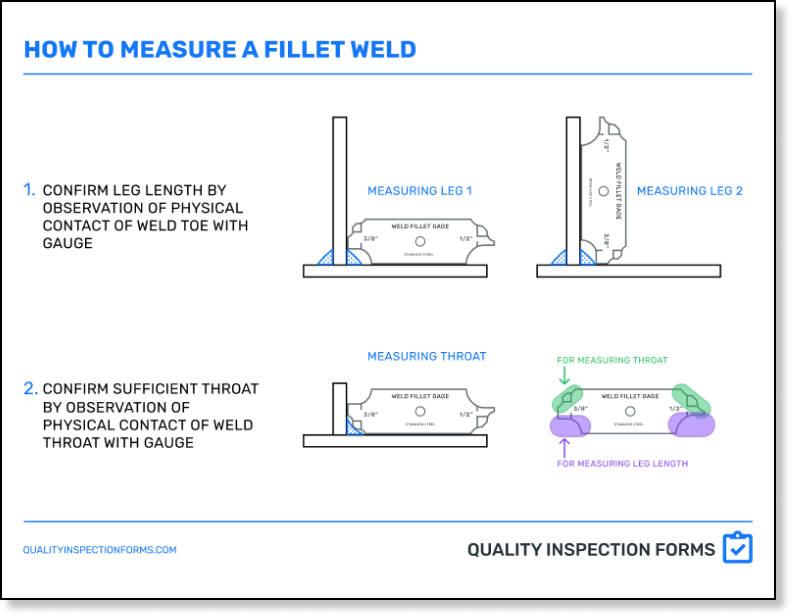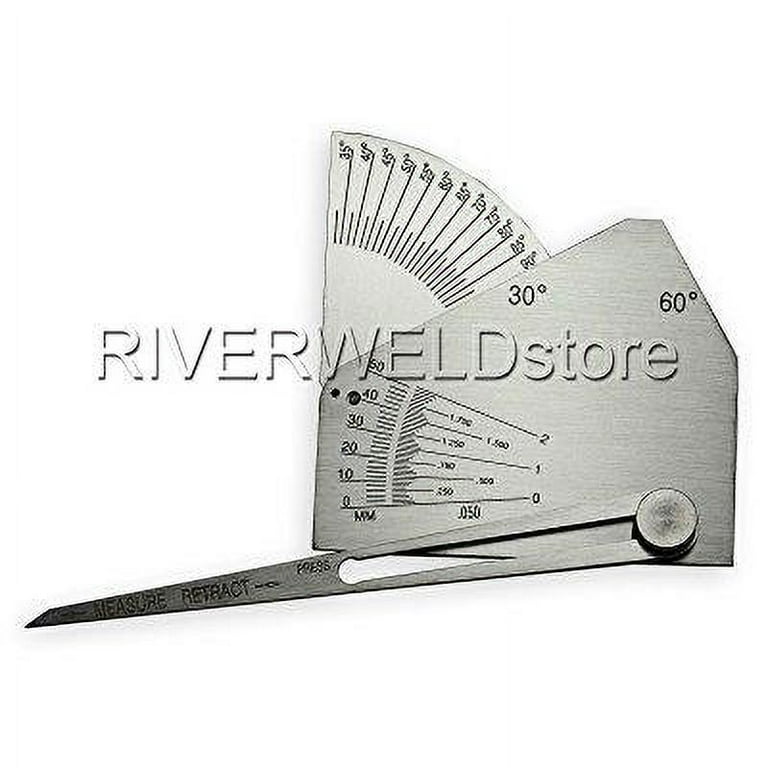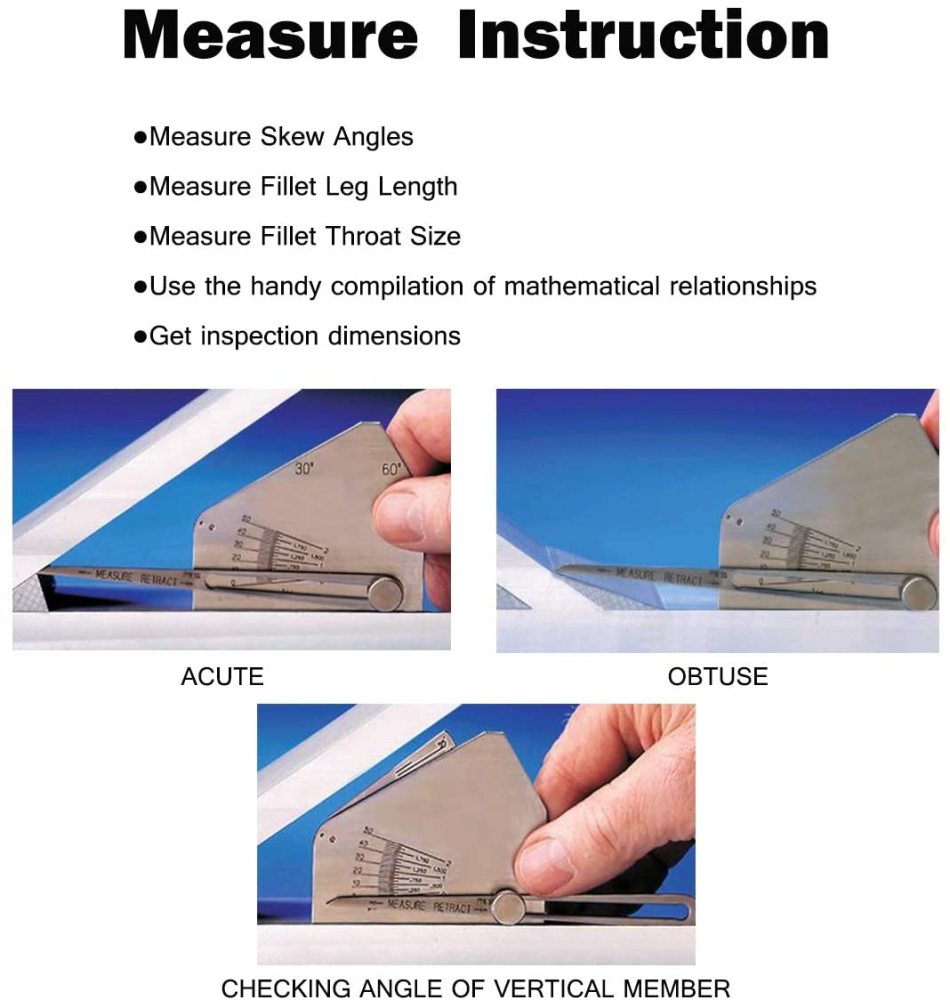Leading Strategies for Measuring Gauge Fillet Weld Properly
Leading Strategies for Measuring Gauge Fillet Weld Properly
Blog Article
Cutting-edge Methods to Fillet Weld Assessment and Testing: Enhancing Weld High Quality and Compliance Standards
In the realm of welding, the high quality and honesty of fillet welds play an essential function in making certain the architectural stability and integrity of various industrial components. With the continuous drive for improved efficiency and conformity with rigorous standards, the expedition of ingenious techniques to fillet weld assessment and screening has actually ended up being crucial. As sectors evolve, the traditional approaches might no more suffice in meeting the demands of contemporary welding applications (Gauge Fillet Weld). By embracing advanced innovations and techniques, a brand-new horizon of possibilities arises in the realm of weld high quality analysis and adherence to compliance requirements.
Advanced Non-Destructive Testing Methods
Using advanced modern technologies, progressed non-destructive screening methods play a vital duty in guaranteeing the honesty and high quality of fillet welds. These methods, such as phased array ultrasonic testing (PAUT) and magnetic bit testing (MPT), offer detailed understandings right into the weld's inner framework without triggering any type of damages to the material. PAUT, for example, makes use of several ultrasonic elements to evaluate the weld from various angles, providing a thorough visualization of potential flaws like lack of fusion or fractures.
By utilizing these innovative non-destructive testing techniques, weld assessors can accurately evaluate the high quality of fillet welds, guaranteeing compliance with industry standards and policies. The ability to discover imperfections early on not just enhances weld high quality yet likewise prevents costly rework or failures in structural honesty, underscoring the relevance of these cutting-edge testing methods in welding examinations.
Robotics and Automation in Evaluation

The combination of robotics and automation has actually revolutionized the examination process for fillet welds, boosting efficiency and precision in top quality analysis. Robotics use exact control and repeatability in inspecting welds, making certain constant and dependable outcomes. Automated systems can be programmed to comply with certain assessment courses, making certain comprehensive coverage of welds and decreasing the threat of human error.
Robotic examination systems outfitted with innovative sensors can discover and determine weld features with high precision, giving detailed information for evaluation. These systems can recognize defects such as splits, absence of combination, and porosity, enabling punctual restorative actions to be taken. In addition, robotics and automation enable real-time information collection and analysis, giving prompt responses to drivers and promoting quick decision-making processes.
Additionally, making use of robotics and automation in fillet weld examination enhances overall efficiency by lowering examination times and raising examination throughput. By enhancing the inspection procedure, makers can ensure weld high quality and conformity standards are fulfilled effectively, eventually causing cost savings and enhanced product high quality.
Making Use Of Artificial Intelligence for Evaluation
Expert system plays a pivotal function in boosting the efficiency and precision of analysis in fillet weld inspection procedures. By utilizing the power of AI, examiners can enhance the evaluation of weld high quality and compliance standards, resulting in much more exact and reputable results. AI formulas can rapidly refine vast amounts of information from weld assessments, identifying defects or incongruities that might be testing to relate to the nude eye. This sophisticated innovation enables real-time monitoring of weld high quality, permitting immediate restorative activities to be taken if any problems are spotted.
Furthermore, AI systems can pick up from past assessment information, consistently improving their ability to identify potential issues and deviations in fillet welds. This adaptive knowing capacity boosts the overall high quality control process, minimizing the likelihood of human error and guaranteeing that welds satisfy the needed requirements. By integrating expert system into fillet weld evaluation, sectors can attain greater degrees of effectiveness, uniformity, and conformity in their evaluation practices.
Portable Devices for On-Site Assessment
Enhancing field evaluation effectiveness, the fostering of mobile devices changes on-site evaluation view processes for fillet welds. These tools offer flexibility and convenience, allowing assessors to perform thorough evaluations in various locations, consisting of remote or difficult atmospheres. Portable devices such as ultrasonic screening gadgets, magnetic bit evaluation equipment, and electronic radiography systems provide real-time information and high-resolution imaging capacities, allowing quick decision-making and immediate responses on weld high quality.
One considerable advantage of mobile tools is their ability to simplify assessment procedures, reducing downtime and boosting total efficiency - Gauge Fillet Weld. Inspectors can conveniently deliver these tools to various task sites, removing the requirement for carrying hefty equipment or components to off-site centers. Additionally, the transportability of these tools advertises cost-effectiveness by decreasing transportation expenditures and speeding up evaluation timelines
Moreover, using portable tools for on-site examination advertises proactive high quality control measures, as examiners can quickly identify and attend to any prospective welding defects or inconsistencies. By incorporating these cutting-edge innovations into on-site evaluation techniques, welding professionals can make certain compliance with market criteria and boost weld top quality, ultimately resulting in boosted architectural integrity and security in numerous welding applications.
Integration of Data Administration Equipment

Having optimized on-site examination procedures through the utilization of mobile tools, the next stage includes the seamless combination of data monitoring systems to additionally improve effectiveness and information analysis capabilities in fillet weld examination and testing. By incorporating data monitoring systems into the examination process, companies can streamline information collection, storage, and analysis. This assimilation enables for real-time monitoring of weld high quality, immediate recognition of defects, and punctual decision-making to rectify any type of issues that may arise during the examination process.
The integration of information monitoring systems makes it possible for smooth interaction between different stakeholders involved in the examination procedure, promoting partnership and enhancing overall top quality control actions. Inevitably, the combination of data management systems offers to raise the standards of fillet weld inspection and screening, making sure compliance with sector guidelines and improving weld quality.
Verdict
Finally, ingenious methods to fillet weld examination and screening have substantially enhanced weld quality and conformity criteria. Advanced internet non-destructive testing approaches, robotics, automation, expert system, portable devices, and information management systems have actually reinvented the way weld assessments are performed. By utilizing these technologies, markets can ensure that welds fulfill the required top quality standards and guidelines, ultimately enhancing overall performance and security in welding procedures.

Having optimized on-site inspection procedures via the utilization of mobile tools, the following phase involves visite site the seamless integration of information administration systems to further enhance performance and information analysis capacities in fillet weld assessment and screening. Ultimately, the assimilation of data monitoring systems serves to elevate the requirements of fillet weld evaluation and screening, guaranteeing conformity with industry laws and improving weld top quality.

Report this page